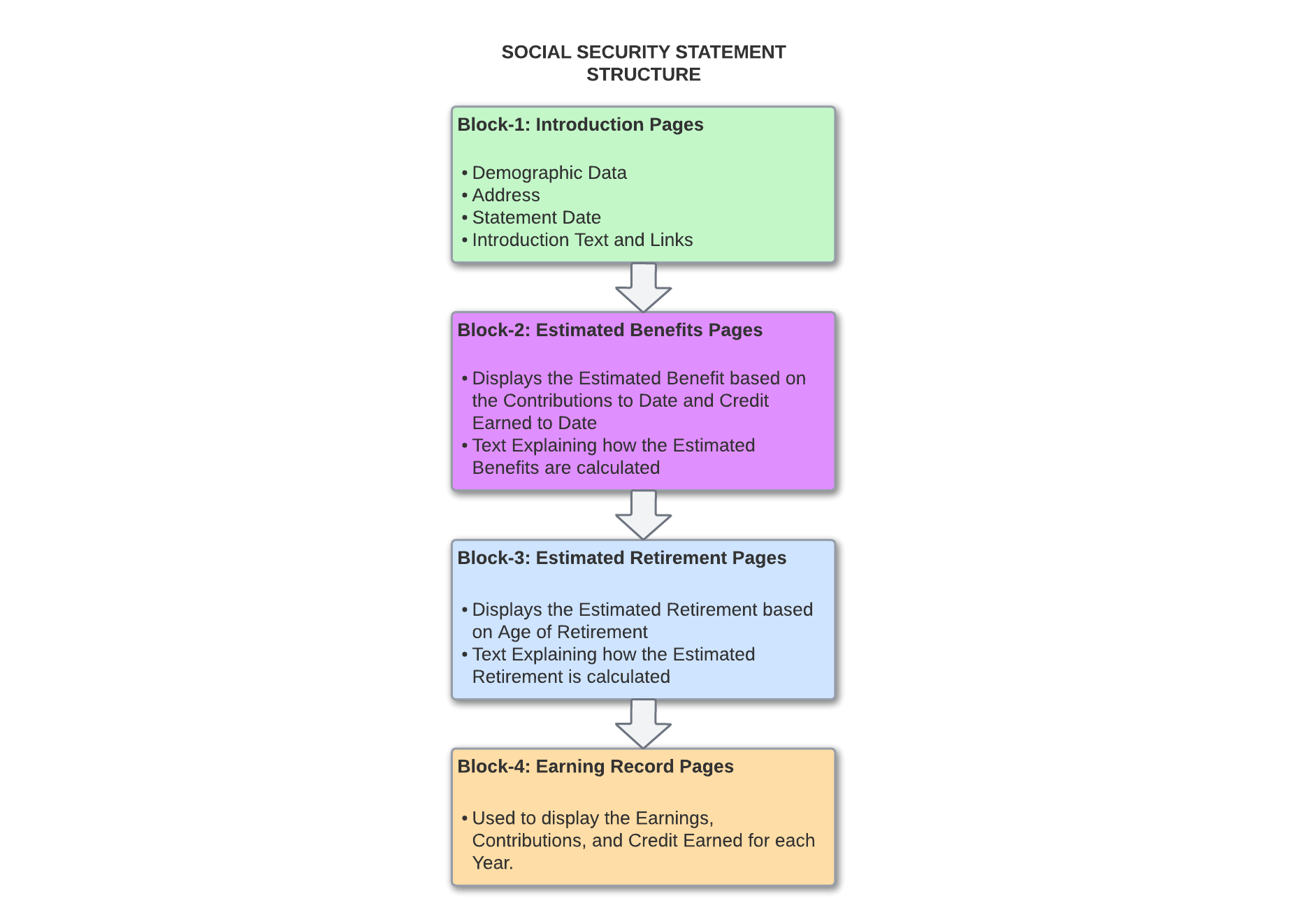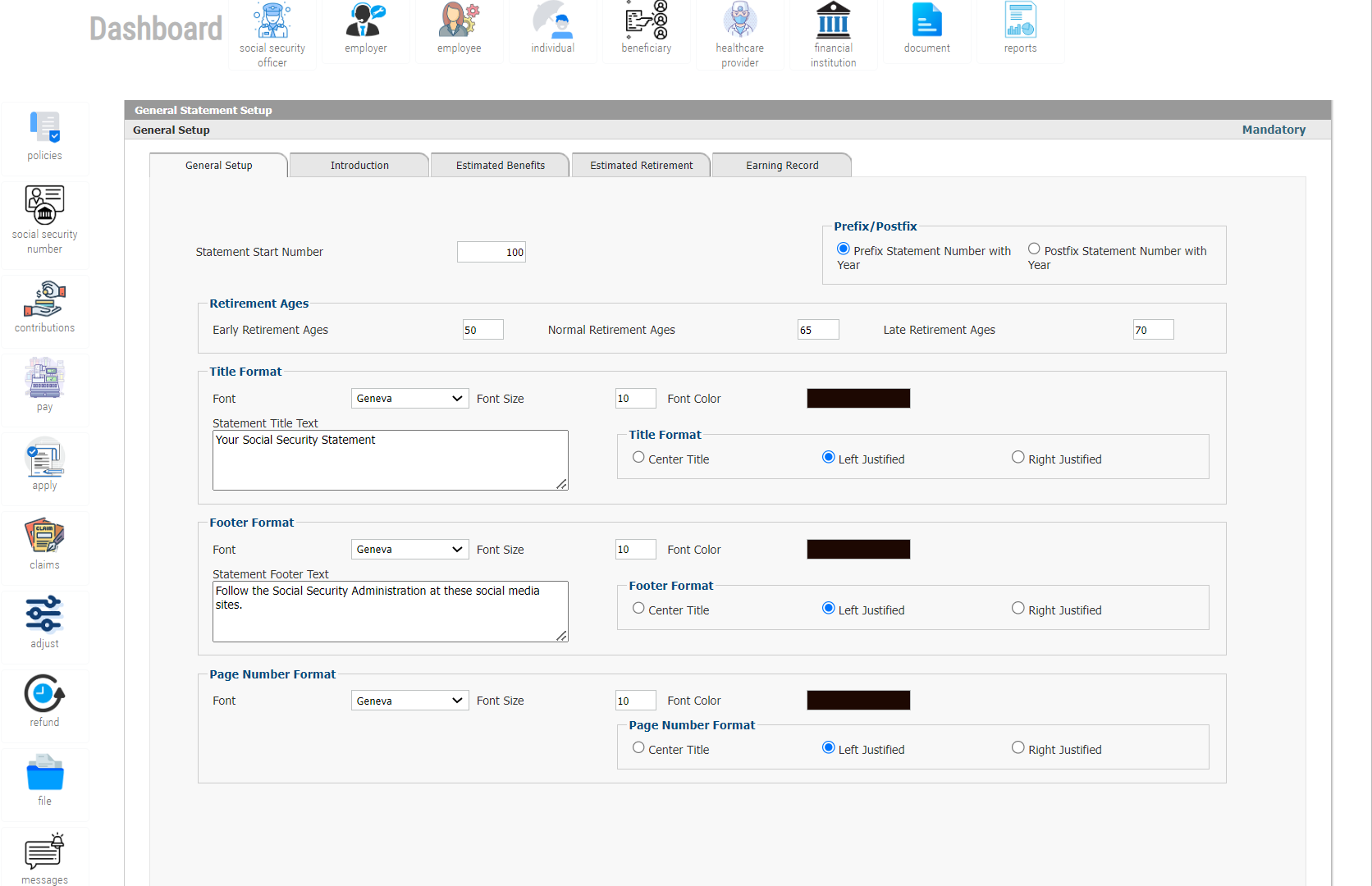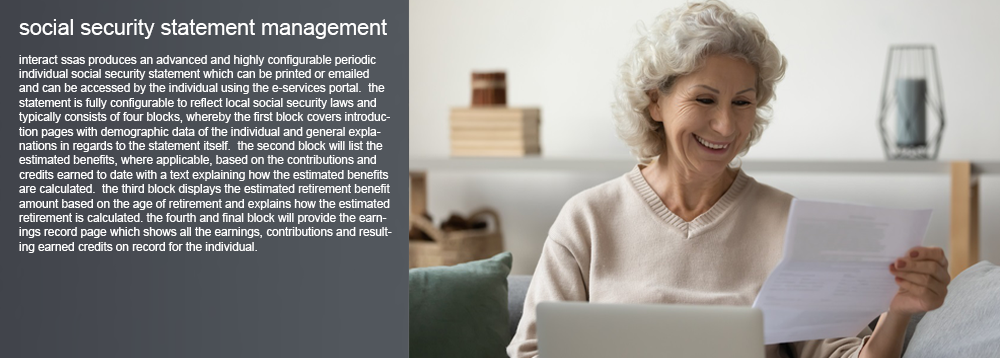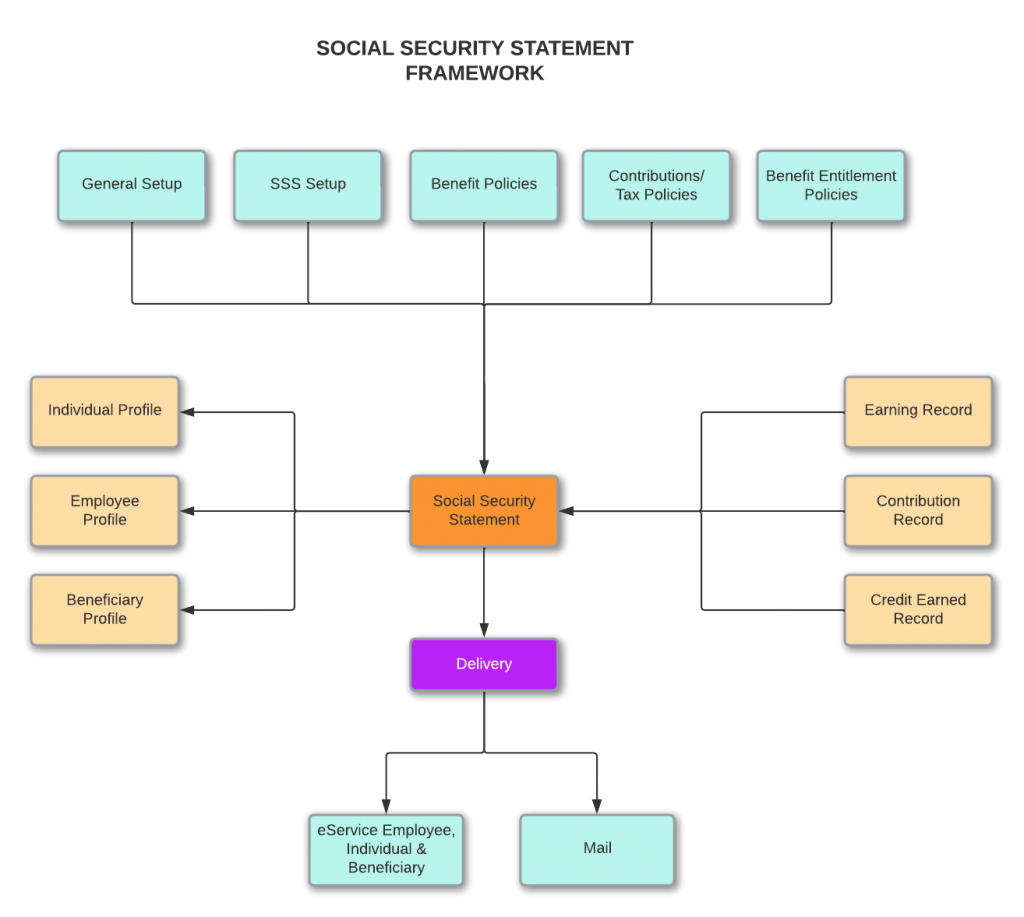Social Security Statement Management is responsible for generating and delivering periodic individual social security statements. These statements provide a comprehensive summary of an individual’s earnings, contributions, and benefit entitlements. The module ensures full configurability to align with each country’s social security regulatory framework. The statement consists of multiple data blocks, displaying personal information, estimated benefits, retirement calculations, and earnings records. Statements can be delivered electronically via e-Services or printed and mailed.
Framework
Figure 1: Social Security Statement Framework
Social Security Statement framework shown in figure-1 does not update any data, but reads existing data already calculated and populated by other SSA processes including Contribution Filing and Contribution Payments and Credit Earned. It uses the Social Security Statement setup and the system policies to generate the Social Security Statement.
The generated Social Security Statement can be delivered through eServices including individual, employee, and beneficiary self-service. However, many countries still use the mail system where the Social Security Statements are printed and sent through the post office (mail).
Structure and Format
The structure of the Social Security Statement consists of three (3) Blocks as whown in Figure-2 below. Each block is used to display specific information. Each block can be one or more pages. Each block has fixed information text defined in the setup and variable information/data read from the database or calculated based on the predefined policies.

Figure-2: Social Security Statement Structure and Format
Block-1 – Used display Individual Demographic Data such as Individual Name, Social Security Number, Date of Birth, Address, Statement Number, Statement Date, and Introduction Text.
Block-2 – Used to Display the Estimated Benefits based on the Benefits Entitlements, and Contributions and Credit Earned to Date, and the Text Explaining how the Estimated Benefits are calculated.
Block-3 – Used to Display the Estimated Retirement based on the Benefits Entitlements, and Contributions and Credit Earned to Date, and the Text Explaining how the Estimated Retirementis calculated.
Block-4 – Used to Display the Earning Record of the Individual including:
- – Year
- – Year Earning
- – Year Employer Contribution
- – Year Employee Contribution
- – Year Total Contribution
- – Year Credit Earned
Features and Processes
Statement Configuration and Design
- Fully configurable statement design and layout.
- Customizable explanatory text for benefits and entitlements.
- Dynamic content updates based on real-time contribution and earnings data.
- Supports automated electronic delivery or traditional mailing.
- Statements generated on a periodic basis, typically annually.
Block-Based Statement Structure The statement is divided into blocks, each containing specific details about the individual’s social security status.
- Block 1: Demographics and General Information
- Displays individual details such as name, social security number, date of birth, and address.
- Includes statement number, statement date, and introductory text.
- Block 2: Estimated Benefits
- Provides estimated benefit amounts based on the contributions and credits earned to date.
- Includes detailed explanations of the calculation methods used.
- Lists various benefit categories such as disability, survivors, and retirement benefits.
- Block 3: Estimated Retirement Benefits
- Shows projected retirement benefit amounts based on retirement age categories:
- Early Retirement Age
- Normal Retirement Age
- Late Retirement Age
- Details when the individual qualifies for each retirement scenario and the estimated monthly benefit amount.
- Configurable policies define calculation rules for each retirement scenario.
- Shows projected retirement benefit amounts based on retirement age categories:
- Block 4: Earnings and Contribution Record
- Displays a detailed record of the individual’s earnings history.
- Lists employer contributions, employee contributions, and total contributions for each year.
- Shows the number of credits earned annually and the cumulative total.
Statement Delivery Options
- Statements can be accessed through the e-Services portal.
- Statements can be emailed directly to the individual.
- Printed statements can be mailed through postal services if required.
Data Sources and Integration
- The module does not update data but retrieves live data from other Interact SSAS processes.
- Pulls information from Contribution Filing and Payments, Benefit Entitlement Policies, and Credit Earned Calculations.
- Uses system policies to generate statements with accurate and up-to-date figures.
Statement Setup and Customization
- Users can configure the statement title, header, footer, and format settings.
- Customizable fonts, colors, and page numbering options.
- Statement numbering can include prefixes or suffixes for organization.
- Retirement ages and entitlement rules are fully configurable within the system.
Workflow for Statement Generation
- Step 1: Statement Setup
- Define general parameters such as title format, numbering format, and explanatory text.
- Configure benefits, credits, and retirement policies.
- Step 2: Data Compilation
- System retrieves contribution, earnings, and benefit entitlement data from integrated modules.
- Apply predefined policies and calculation formulas to generate estimated benefits.
- Step 3: Statement Generation
- Statements are generated for all registered individuals who have contributed to social security.
- Users can manually generate statements for specific individuals if required.
- Step 4: Review and Approval
- Statements are reviewed for accuracy before distribution.
- Administrators can preview, edit, or adjust statements before finalizing them.
- Step 5: Statement Distribution
- Individuals can access statements via their e-Services accounts.
- Statements can be emailed to registered individuals.
- Printed copies can be mailed to individuals who prefer paper statements.
Audit and Compliance Features
- Ensures compliance with local social security regulations.
- Tracks historical statements for future reference and audits.
- Allows authorized users to review statement history and adjustments.
- Configurable access control restricts statement modifications to authorized personnel.
Integration with Other Modules
- Contribution Filing & Payment Management: Ensures earnings and contributions are accurately reflected.
- Benefit Entitlement Policies: Defines benefit calculations based on credit earned.
- e-Services Portal: Provides electronic access for individuals to view their statements.
- Mailing and Notifications Module: Automates statement distribution via email or postal services.
Social Security Statement Management provides a structured, automated process for generating and distributing social security statements. With full configurability, real-time data integration, and multi-channel distribution, the module ensures individuals receive clear and accurate records of their contributions and entitlements. By streamlining statement generation and delivery, the system enhances transparency and supports compliance with social security policies.

Figure 3: Social Security Statement Setup
Social Security Statement Management produces an advanced and highly configurable periodic individual social security statement. The content and design of the Social Security Statement is fully configurable so that it reflects the regulatory framework for social security in the country. Depending on the configuration, the statement can consist of four blocks, whereby the first block shows the individual’s demographic data, the second block gives the estimated benefits based on the contributions and credits earned to date, the third block displays the individual’s estimated retirement benefit amount earned so far and the fourth block shows all the individual’s earnings, contributions and earned credits. Each block can contain detailed explanations on policies and calculations for the items that are displayed in the block. All statements are dynamic and reflect live data for only those benefits relevant for the individual. Social Security Statements can be e-mailed or made available to individuals through the e-Services portal.
- Fully Configurable Statement Explanatory Text
- Fully Configurable Statement Calculations
- Statement Available in e-Services
- Statement Available for e-Mailing or Printing
- Block Based Framework
- Block 1: Demographics and Explanations
- Block 2: Estimated Benefits and Explanations
- Block 3: Estimated Retirement Benefits
- Block 4: Earnings Record

Figure 4: Social Security Statement – Earning Record Configuration
Overview
Social Security Statement is a Periodic Statement that is sent to any individual registered with the Social Security Administration and who is contributing to Social Security Benefits. It is used to provide the individual with his/her earnings, contributions, credit earned, and benefits entitlement during the year and year to date and the totals. The Social Security Statement is produced annually. The format and contents of the Social Security Statement vary from country to country. However, the Social Security Statement generally includes:
- – Individual Name
- – Social Security Number
- – Address
- – Statement Date
- – Earnings Year
- – Year Contributions
- – Year Credit Earned
- – Year to Date Earnings
- – Year to Date Contributions
- – Year to Date Credit Earned
- – Total Earnings to Date
- – Total Contributions to Date
- – Total Credit Earned to Date
- – Entitlements – This is a frame that shows what the individual is entitled for based on his/her Credit Earned:
- Benefit-1 Required Credits: XX Credit Earned: YY
- Benefit-2 Required Credits: XX Credit Earned: YY
- Benefit-3 Required Credits: XX Credit Earned: YY
- – Retirement Benefit – This shows when the Individual Minimum Age of Retirement and when
he/she is eligible for retirement based on his/her date of birth and include: - – Minimum Age of Retirement known as Early Retirement
- – Normal Retirement Age
- – Late Retirement Age
- – Individual Date of Birth
- – Individual Age
- – Date Individual Qualifies for Early Retirement
- – Based on Credit Earned if the Individual takes Early Retirement, he/she will Receive $ XXX.XX per month
- – Date Individual Qualifies for Normal Retirement
- – Based on Credit Earned if the Individual takes Normal Retirement, he/she will Receive the following $ XXX.XX per month
- – Based on Credit Earned if the Individual takes Late Retirement, he/she will Receive the following $ XXX.XX per month
Note that all entitlements for Benefit are defined in the Benefit Entitlement Policy. The Retirement Benefit is tagged as “Retirement” using a flag in the Benefit Policy. The calculation of the Retirement Amount Entitlement is defined in the Benefit Entitlement Policy as well as the variables including Early Retirement Age, Normal Retirement Age, and Late Retirement Age. See attached sample of Social Security Statement of the US Social Security Administration.


